Europe, British Isles, North-West Wales aka Gwynedd, Anglesey, Plas Newydd Burial Chamber [Map]
Plas Newydd Burial Chamber is in Plas Newydd, Anglesey, Prehistoric Anglesey Burial Chambers.
Plas Newydd Burial Chamber [Map]. By the stables of the National Trust House.
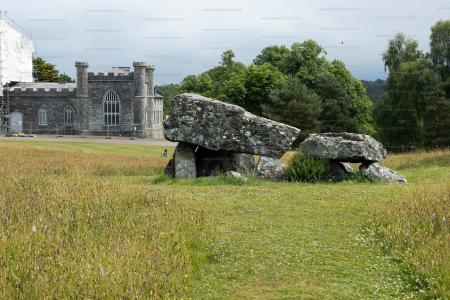
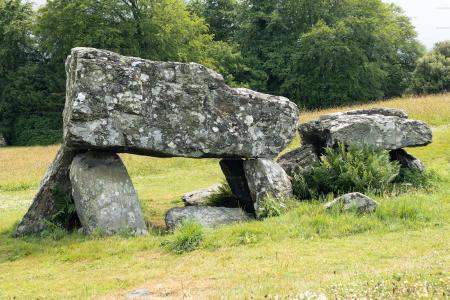
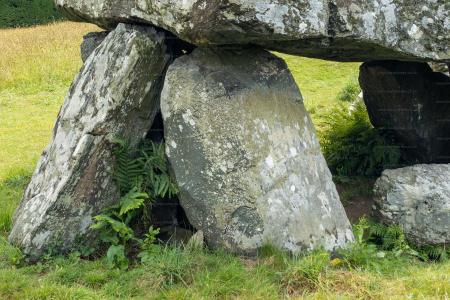
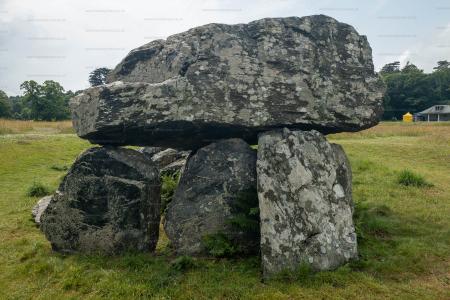
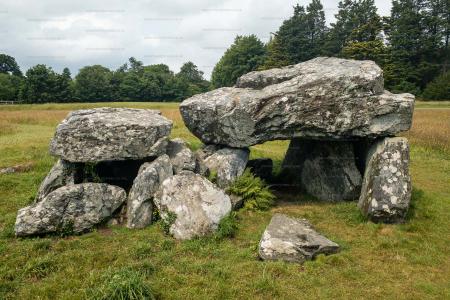
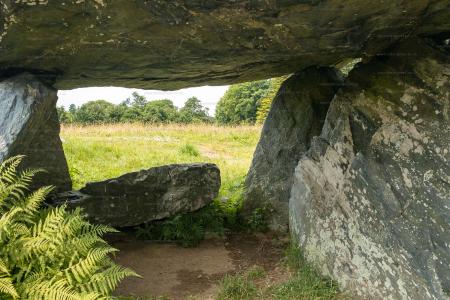
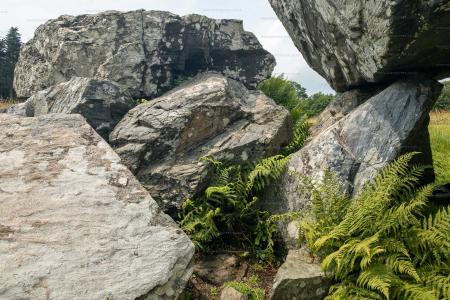
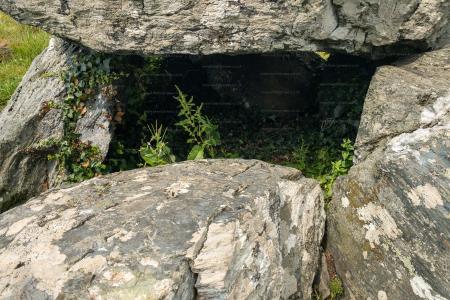
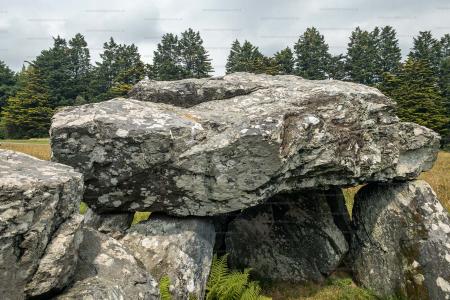
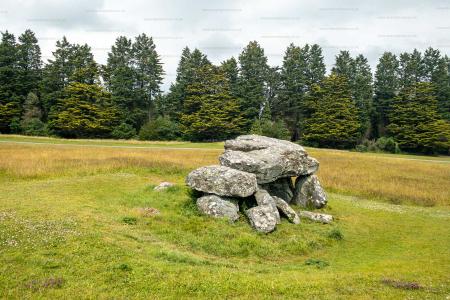
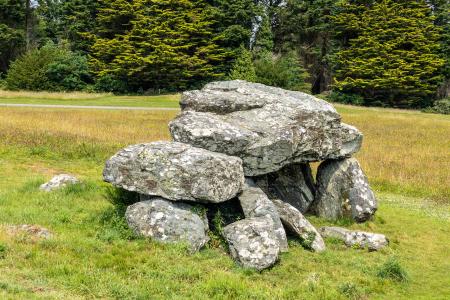
Mona Antiqua Restauranta 93 Druidical Monuments. But of such Cromleche as remain yet undemolished, there is but one besides that at Bodowyr to be seen in all these precincts ; and that a very large one, before mentioned, slanding near Plâs newydd [Map], formerly Llwyn Moel, where it is probable one of their larger groves was. It is a double1 Cromlech, a larger and a smaller contiguous together. There is also at Plâs newydd wood one of the largest Carnedds in the Isle of Anglesey; yet scarce discerned and distinguished from a mount of earth, the stones being overgrown with earth and moss, and great trees growing thick upon it. It lies in a dry bottom, without any pillars now standing by it, fig. 2. There are also in Llanddaniel parish, at a place called formerly Llwyn Llwyd, now Bryn Kelli [Map], the remains of two Carnedds, within a few paces of one another; the one, fig. 3. is somewhat broken and pitted into on one side, where the stones have been carried away; the other, fig. 4. having had its stones almost all taken away into walls and buildings, with two standing columns erected between them.
Note 1. See plate VII. fig. I.
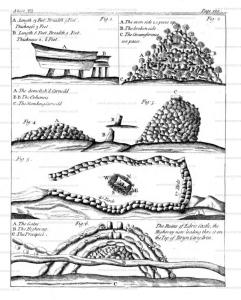
A Second Walk Through Wales. We proceeded to the mansion of Plas-Newydd through the park, an inclosure of no great extent, but extremely beautiful, gently sloping to the Menai, and covered with venerable oaks, and noble ash trees. In the midst of this fine sylvan scene, stand two august and most appropriate ornaments, relics of Druidical superstition, and monuments of the rude art of the ancient British, by far the greatest and most perfect specimens of Druidical remains [Plas Newydd Burial Chamber [Map]] in the whole island. They are what antiquaries call cromlechs.
These huge piles stand contiguous to each other, (as is, I believe, generally the case with respect to the cromlech) but the eastern is considerably the larger of the two. This seems originally to have consisted of seven stones, six uprights supporting an immense superincumbent one, (with its flat face lying upon them) thirteen feet long, nearly as much broad, and four feet thick. When first constructed, it would probably have admitted a tall man to stand upright in it. The western cromlech is a child to its mighty neighbour, little more than five feet long by four and half broad; originally supported by four stones, one of which is fallen from its proper situation.
Whether or not these prodigious piles of stones were raised to the honour of the Deity, or to the memory of the departed hero, would lead us into a field of enquiry too wide for a letter to investigate. Both opinions have had their able advocates; but the weight of argument seems to preponderate on that side which ascribes the cromlech to the purposes Whether or not these prodigious piles of stones were raised to the honour of the Deity, or to the memory of the departed hero, would lead us into a field of enquiry too wide for a letter to investigate. Both opinions have had their able advocates; but the weight of argument seems to preponderate on that side which ascribes the cromlech to the purposes
Cambrian Intinerary. At a little distance from the house is one of the largest and most entire cromlechs [Plas Newydd Burial Chamber [Map]] in the whole principality. It is double, and consists of a greater and a less: the greater is twelve feet long by twelve broad, six high, and the upper edge two feet thick. This cromlech rested originally on five stones, hut one being detached or thrown down, four only bear its weight at present, leaving a space between, of five feet high, and six square. The smaller adjoins closely to the narrow end of this, and is six feet square, resting on three si ones, the fourth having fallen down. Not far from hence, is a large carnedd, part of which, being removed, discovered a cell, seven feet long and three wide, covered with two flat stones, and lined with others. On the top of one of these stones were two semicircular holes, large enough to take in the human neck, which evidently prove it to have been the place of interment of some great personage.
Tour Through North Wales. But, to proceed in my narrative. A hundred yards behind the house are two Cromlechs [Plas Newydd Burial Chamber [Map]], the larger of which is the handsomest and most perfect of any I had seen; the perpender is thirteen feet and a half long, about eleven feet broad, and three and a half feet thick ; these dimensions give it a noble appearance. Some time before I saw it, it was supposed that some of its supporters had given way on one side, which greatly alarmed the family ; it was, in consequence, propped up with pieces of thick timber, and this has entirely destroyed the effect of that picturesque simplicity, which characterizes these ancient remains: but I really think there was not the slightest cause for this alarm ; for the whole appeared to me to be well sustained ; at all events, wood was a very injudicious auxiliary to stone.
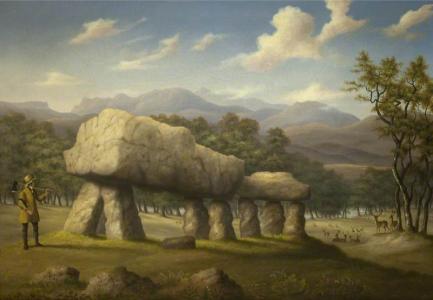 Around 1835. Richard Tongue (age 40). Plas Newydd Burial Chamber [Map].
Around 1835. Richard Tongue (age 40). Plas Newydd Burial Chamber [Map].
Archaeological Journal Volume 3 Page 39. The most celebrated cromlech in the island is that of Plas Newydd [Map], of which we have given a view. It is a double cromlech-as about one half of these monuments always are-and is interesting from its fine preservation and highly picturesque position. We are not aware of any excavations having been made beneath it: but there is every appearance, from the formation of the ground, of its having been once surrounded by a carn or heap of stones; what the second and smaller cromlech meant in these cases, we do not know; probably it served as the tomb of the wife, or the son, of the deceased chieftain. Rowlands mentions a large carn or mound of stones as not far from this cromlech, but grown over, even in his days, by a luxuriant vegetation of wood. There are so many points of the undulating and richly wooded grounds of the Marquis of Anglesey's seat, corresponding to this description, that we do not know how to fix upon the precise locality, but we have little doubt, from the words of the author of the "Mona Antiqua," that, could this mound be excavated, we should find in it a sepulchral chamber con- structed in the true cromlech fashion. On a farm in this immediate neighbourhood at a spot called Bryn Celli, is a tumulus with a passage opened right through it, this passage descends towards the middle of the mound, and then again mounts to upper air: in the middle we come to a chamber, if it can be so called, which is nothing more nor less than the interior of a cromlech; Gough, in his addition to Camden, gives an account of it, and it is there mentioned as having been found to contain human bones; at present it is a refuge for sheep in wet weather.
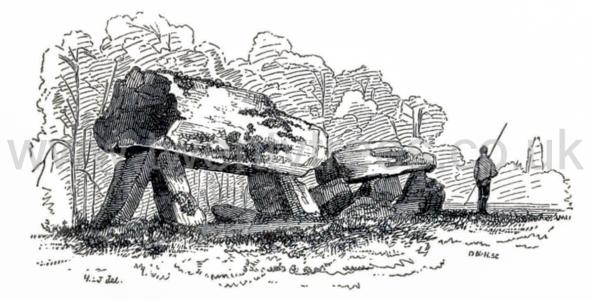
Archaeologia Cambrensis 1854 Page 205. A double Cromlech [Ty Newydd Burial Chamber [Map]],—Close to the house of Trefor, on the road from Beaumaris to Pentraeth, in a field on the south side of the road. They were erect not many years since, but were then thrown down by the tenant, because they were superstitious. (For "they were," read, "he was.")
A double Cromlech [Plas Newydd Burial Chamber [Map]],—In the park of Plas Newydd. This has been often engraved and described. (See Pennants' Tour in Wales; Journal of the Archaeological Institute, &c.) Traces of the carnedd of stones which once covered it are still visible.
Cromlech [Bryn Celli Ddu Burial Mound [Map]],—With passage of stones covered over, at Bryn Celli du, near Plas Newydd. This has been fully described and illustrated in the Archaologia Cambrensis? It is styled Yr Ogof, or the Cave, on the Ordnance map, from its having been always considered so until the superincumbent carnedd was removed. It is now securely fenced off, and preserved from future injury, by the care of C. Evans, Esq., of Plas Gwyn, acting on behalf of the Marquis of Anglesey. This is almost an unique instance of the kind in Wales.
Cromlech,—Near Llanidan Old Church, to the south-west ; it is partly thrown down. Cromlech,
At Bodowyr [Bodowyr Burial Chamber [Map]], near Llangaffo. This is one of the smallest cromlechau known, and is in admirable preservation. (See Journal of the British Archaeological Association.)
Archaeologia Cambrensis 1862. Drawings of the Cromlechs at Plas Newydd [Map] and Presaddfed [Map].
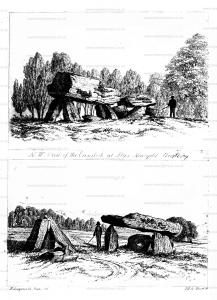
Archaeologia Cambrensis 1870 Page 51. On The Tumulus In Plas Newydd Park [Map], Anglesey.
Rude Stone Monuments in all Countries Chapter IV. Almost all the so-called dolmens in the Channel Islands are of this class. One has already been given (woodcut No. 11), and it may safely be asserted that all chambers which were wainscoted with slabs, so as to form nearly perfect walls, and all that had complicated quasi-vaulted roofs were, or were intended to be, covered with mounds - more especially those that had covered pas- sages leading to them. There is, however, a very wide distinction between these sepulchral chambers and such a monument as this at Pentre Ifan [Map], in Pembrokeshire1. The top stone is so large that it is said five persons on horseback have found shelter under it from a shower of rain. Even allowing that the horses were only Welsh ponies, men do not raise such masses and poise them on their points for the sake of hiding them again. Besides that, the supports do not and could not form a chamber. The earth would have fallen in on all sides, and the connexion between the roof and the floor been cut off entirely, even before the whole was completed. Or, to take another example, that at Plas Newydd [Map], on the shore of the Menai Strait. Here the cap stone is an enormous block, squared by art, supported on four stone legs, but with no pretence of forming a chamber. If the cap stone were merely intended as a roofing stone, one a third or fourth of its weight would have been equally serviceable and equally effective in an architectural point of view, if buried. The mode of architectural expression which these Stone men best understood was the power of mass. At Stonehenge, at Avebury, and everywhere, as here, they sought to give dignity and expression by using the largest blocks they could transport or raise - and they were right; for, in spite of their rudeness, they impress us now; but had they buried them in mounds, they neither would have impressed us nor their contemporaries.
Note 1. 'Archæologia Cambrensis,' third series, xi. p. 284
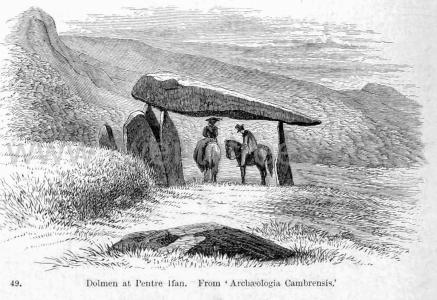
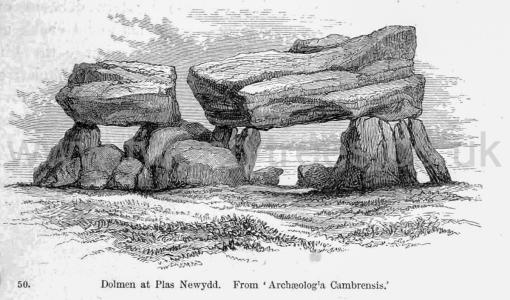
Honourable Society of Cymmrodorion 1910. Perhaps no megalithic remains in these islands have been more frequently illustrated than the two standing dolmens at Plas Newydd [Plas Newydd Burial Chamber [Map]], in the parish of Llanedwen, and one mile north of the Church. Rowlands gives but a poor description1 of them. He makes the larger capstone 13 ft. long, 9 ft. wide, and 3 ft. thick, and the smaller, 6 ft. long by 5 ft. and 2 ft. 6 ins. thick. Pennant supplies2 a few more details. He gives the measurements of the larger capstone as 12 ft. 7 ins. long by 4 ft., and says that it rested on five tall stones. The smaller one he describes as 5 ft. 6 ins. long, supported on four stones. An engraving by Moses Griffith gives some idea of its condition in 1770. Bingley's account3 tells us that the larger capstone "formerly rested on five upright supporters but some years ago, after some heavy rain, the one at the back suddenly split, since which time it has been necessary to prop it with supporters of wood Richard Warner, in one of his Walks through Wales, 17994 says that the larger dolmen seemed originally to have consisted of seven stones, that is, six uprights supporting an immense superincumbent stone, with its flat side lying upon them, this stone being 13 ft. long by 4 ft. 6 ins. broad, and had originally been supported by four stones, one of which had fallen from its proper position. Thomas Evans, in the Camb. Itin., 18015, states that the larger capstone "rested originally on five stones, but one being detached or thrown down, four only bear its weight at present", the smaller one rested on three stones, the fourth having fallen down. Skinner gives no further details, neither does he mention the number of supporters: he, however, made a sketch of the dolmens. Pugh, in 18166 says: "Sometime before I saw it, it was supposed that some of its supporters had given way on one side, which greatly alarmed the family; it was in consequence, propped up with pieces of thick timber, and this has entirely destroyed the effect wood was a very injudicious auxiliary to stone". In Evans' (Brayley and Britten) Beauties of North Wales7, the larger capstone is described as "resting on six uprights, four at the broadest end and two at the other end, two fallen stones lie underneath". Miss Llwyd, quoting from her father's MSS.8, says the larger capstone is 12 ft. 7 ins. by 11 ft. and 4 ft. thick, the north end supported by four stones or perhaps three, the middle one being split. She also quotes from Monumenta Antiqua, where it is stated that this capstone was apparently supported years ago by five tall stones near the upper end, of which only three then remained.
Note 1. H. R., p. 47.
Note 2. T. P., ii, p. 236.
Note 3. W. B., p. 202.
Note 4. R. W., p. 297.
Note 5. T.E. p. 370.
Note 6. E.P., p. 277.
Note 7. p. 282.
Note 8. A. Ld., p. 239.